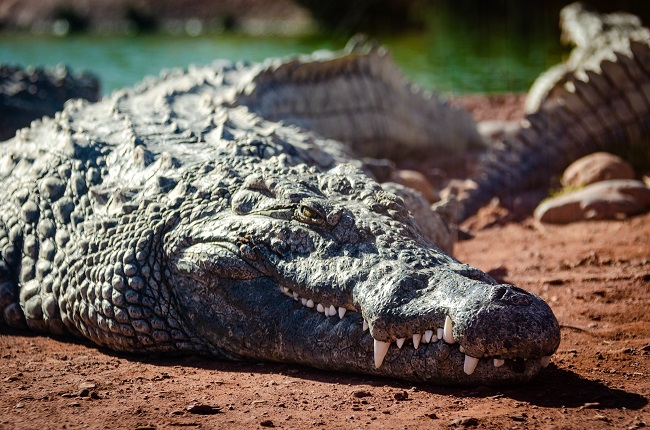
In the brackish and murky waters of the world’s tropical and subtropical regions, a prehistoric predator reigns supreme: the saltwater crocodile (Crocodylus porosus). With its formidable size, ancient lineage, and unparalleled hunting prowess, this apex predator is a living testament to the resilience of nature’s design. Native to coastal habitats throughout Southeast Asia, Australia, and parts of the Indian subcontinent, the saltwater crocodile stands as a captivating and fearsome creature.
Native Habitats and Distribution
Saltwater crocodiles have a remarkable range that spans across a vast expanse of aquatic environments. These habitats include coastal estuaries, mangrove swamps, rivers, and even open ocean waters near shorelines. They are found across a wide geographical area, encompassing countries such as Australia, Indonesia, India, and parts of Southeast Asia.
Mangrove swamps, with their labyrinth of tidal channels and dense vegetation, serve as crucial breeding and nesting grounds for these reptiles. The crocodiles’ ability to move between saltwater and freshwater environments is a testament to their adaptability and endurance.
Average and Record Specimens
Saltwater crocodiles are the largest living reptiles on Earth. Adult males can reach lengths of 16 to 23 feet or even more, while females tend to be smaller, ranging from 9 to 13 feet. Exceptional individuals have been recorded at lengths exceeding 23 feet, and reports suggest even larger specimens existed historically.
One legendary saltwater crocodile, known as “Lolong,” held the record as the world’s largest captive crocodile until its passing in 2013. Lolong measured a staggering 20 feet and 3 inches in length and weighed over a ton. Such records highlight the awe-inspiring dimensions these reptiles can attain.
Role in the Ecosystem
As apex predators, saltwater crocodiles play a vital role in maintaining the balance of their ecosystems. Their predatory behavior helps control the populations of various species, preventing overpopulation and ensuring the health of prey populations.
Crocodiles also scavenge on carrion, consuming deceased animals that might otherwise become breeding grounds for disease. By cleaning up carcasses, these reptiles contribute to the overall cleanliness of their habitats and help limit the spread of pathogens.
Furthermore, their burrows serve as shelters for various species during storms and periods of extreme weather. The digging of these burrows aids in soil aeration and water retention, which can indirectly impact the surrounding landscape.
Human Interaction and Conservation
The fearsome reputation of saltwater crocodiles has led to conflicts with humans, especially in regions where human activities overlap with crocodile habitats. Attacks on humans and livestock can occur, and crocodile management strategies must balance human safety with the conservation of these apex predators.
Conservation efforts aim to protect saltwater crocodile populations and their habitats while minimizing human-wildlife conflicts. This involves habitat preservation, educational programs, and responsible management of crocodile populations to ensure their survival while safeguarding human communities.
Conclusion
The saltwater crocodile’s dominance in its native habitats, combined with its sheer size and ancient lineage, makes it a true marvel of nature. Evolving over millions of years to become a powerful predator, this reptile’s role in shaping ecosystems cannot be overstated.
13 Fun Facts About the Saltwater Crocodile
Ancient Lineage: Saltwater crocodiles are often referred to as “living fossils” because they have been around for about 240 million years, making them one of the oldest living reptile species on the planet.
Size Matters: They are the largest living reptiles, with some individuals reaching lengths of over 23 feet and weighing up to 2,205 pounds.
Superb Swimmers: Saltwater crocodiles are excellent swimmers and can cover long distances at sea. They’ve been known to travel hundreds of miles, and their ability to navigate in both saltwater and freshwater habitats is a testament to their adaptability.
Impressive Jaws: With a bite force of around 3,700 pounds per square inch (psi), saltwater crocodiles have one of the most powerful bites in the animal kingdom. Their jaws are designed to crush bones and tear through tough prey.
High and Dry: Despite their name, saltwater crocodiles can tolerate freshwater environments as well. They have specialized glands near their eyes that excrete excess salt, allowing them to regulate their salt levels.
Epic Breeding Migrations: These crocodiles engage in epic breeding migrations during the wet season. They travel from their coastal habitats upstream to lay their eggs in freshwater areas. The journey can cover significant distances.
Incredible Camouflage: Saltwater crocodiles have remarkable camouflage that allows them to blend into their surroundings. Their dark coloration helps them ambush prey while hiding in the shadows of the water.
Highly Intelligent: Research has shown that crocodiles are intelligent animals capable of problem-solving and learning. They can learn to associate sounds with food and even remember the locations of suitable nesting sites.
No Sweat: Crocodiles don’t have sweat glands, so they cool off by opening their mouths wide to release excess heat.
Caring Parents: Despite their fearsome reputation, saltwater crocodiles exhibit surprisingly nurturing behavior toward their young. Mothers guard their nests and help transport their hatchlings to water, offering them protection during the vulnerable early stages of life.
Ecosystem Engineers: Saltwater crocodiles are ecosystem engineers. Their burrows provide shelter for other animals during harsh weather conditions, creating microhabitats within their habitats.
Cultural Significance: In some cultures, saltwater crocodiles hold symbolic significance. They are revered as powerful and often feature in folklore and mythology.
Underwater Stealth: Their eyes and nostrils are positioned on the top of their head, allowing them to remain mostly submerged while keeping an eye on their surroundings.
Related Articles & Free Email Newsletter Sign Up
The American Alligator: A Vital Component of Ecosystem Balance
The Reticulated Python: A Majestic Serpent with Ecological Consequences
Wild Boar in America: History, Impact, and Conservation Efforts


Comment here